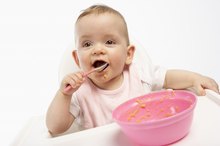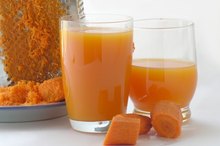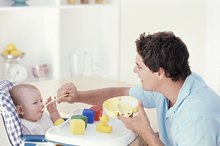When to Start Feeding Baby Stage 3 Gerber Foods
Your baby goes through many physical and mental stages in his first year. The same can be said for his diet. He goes from only drinking breast milk or formula to eating regular foods by the end of his first year. By the time he is about 8 or 9 months old, he can begin to eat Gerber Stage 3 foods, also known as Gerber NatureSelect 3rd Foods.
Introduction to Solid Foods
At about 4 months old, your baby can begin to eat solid foods. These solid foods include baby cereals and runny, pureed fruits and vegetables. These foods are considered Stage 1 foods by Gerber. When your baby is 6 months old, she can start to have Stage 2 foods, which are a little thicker and have larger serving sizes.
- At about 4 months old, your baby can begin to eat solid foods.
- When your baby is 6 months old, she can start to have Stage 2 foods, which are a little thicker and have larger serving sizes.
Gerber Stage 3 Foods
4-Month-Baby Diet
Learn More
Gerber Stage 3 foods are the final foods your baby will eat before he graduates to table foods. Stage 3 foods are similar to the foods he had at Stages 1 and 2, but Gerber NatureSelect 3rd Foods include small pieces of table food mixed in 1. Stage 3 foods are intended to help introduce this "real" food into your baby's diet and help him to get used to the texture and chewing that's involved in processing table food.
Starting Baby on 3rd Foods
Unless your pediatrician says otherwise, you can start your baby on Stage 3 foods when she's about 8 months old. Initially, you'll give him small bites so that he is not taken by surprise by the little pieces of food that are mixed in. Give him a chance to play with these little pieces so he can get used to chewing them. Once he shows he's capable of handling the pieces of food, you can give him bigger spoonfuls at a more rapid rate. As with any new food your baby eats, try one new food at a time to check for any potential allergic reaction.
- Unless your pediatrician says otherwise, you can start your baby on Stage 3 foods when she's about 8 months old.
- Once he shows he's capable of handling the pieces of food, you can give him bigger spoonfuls at a more rapid rate.
When to Stop
When Do Babies Stop Jar Food?
Learn More
There's no set time when you should stop giving your baby Gerber NatureSelect 3rd Foods. It is up to you. When you think she's capable of handling chunks of food on her own, you can begin to transition her onto table foods. For some kids, this might only take a couple of weeks of Stage 3 feedings; for others, it might take longer. By 10 months, she should be ready to move on to table foods.
- There's no set time when you should stop giving your baby Gerber NatureSelect 3rd Foods.
- When you think she's capable of handling chunks of food on her own, you can begin to transition her onto table foods.
Table Foods
When your baby is eating table foods, he's essentially done with baby food. Any progress made going forward in eating will simply mean he can have bigger pieces of table foods. Once he's on table foods, there's no need to go back to the pureed foods. As the name of the Gerber Graduates line suggests, he's now ready for anything he's capable of putting in his mouth and chewing.
- When your baby is eating table foods, he's essentially done with baby food.
Related Articles
References
- Wholesome Baby Food: The Stages of Baby Solid Food and Solid Food Feeding
- BabyCenter: Age-by-Age Guide to Feeding Your Baby
- Koplin JJ, Allen KJ, Gurrin LC, et al. The impact of family history of allergy on risk of food allergy: a population-based study of infants. Int J Environ Res Public Health. 2013;10(11):5364–5377. Published 2013 Oct 25. doi:10.3390/ijerph10115364
- American Academy of Pediatrics. Infant Food and Feeding. AAP.org. Published 2020.
- American Academy of Pediatrics. Committee on Nutrition. Hypoallergenic infant formulas. Pediatrics. 2000;106(2 Pt 1):346-9. doi:10.1542/peds.106.2.346
- Ferraro V, Zanconato S, Carraro S. Timing of Food Introduction and the Risk of Food Allergy. Nutrients. 2019;11(5):1131. Published 2019 May 21. doi:10.3390/nu11051131
- Cabana MD. The Role of Hydrolyzed Formula in Allergy Prevention. Ann Nutr Metab. 2017;70 Suppl 2:38-45. doi:10.1159/000460269
- National Collaborating Centre for Women's and Children's Health (UK). Identification and management of trigger factors. Atopic Eczema in Children: Management of Atopic Eczema in Children from Birth up to the Age of 12 Years. Published December 2007.
- Abeshu MA, Lelisa A, Geleta B. Complementary Feeding: Review of Recommendations, Feeding Practices, and Adequacy of Homemade Complementary Food Preparations in Developing Countries - Lessons from Ethiopia. Front Nutr. 2016;3:41. Published 2016 Oct 17. doi:10.3389/fnut.2016.00041
- Hagan JF, Shaw JS, Duncan PM. Bright Futures: Guidelines for Health Supervision of Infants, Children, and Adolescents. Elk Grove Village, IL: Bright Futures/American Academy of Pediatrics; 2017.
- NIAID-Sponsored Expert Panel, Boyce JA, Assa'ad A, et al. Guidelines for the diagnosis and management of food allergy in the United States: report of the NIAID-sponsored expert panel. J Allergy Clin Immunol. 2010;126(6 Suppl):S1–S58. doi:10.1016/j.jaci.2010.10.007
- Abrams EM, Becker AB. Food introduction and allergy prevention in infants. CMAJ. 2015;187(17):1297–1301. doi:10.1503/cmaj.150364
- Koo YC, Chang JS, Chen YC. Food claims and nutrition facts of commercial infant foods. PLoS One. 2018;13(2):e0191982. Published 2018 Feb 28. doi:10.1371/journal.pone.0191982
- Van den boom S, Kimber AC, Morgan JB. Nutritional composition of home-prepared baby meals in Madrid. Comparison with commercial products in Spain and home-made meals in England. Acta Paediatr. 1997;86(1):57-62. doi:10.1111/j.1651-2227.1997.tb08833.x
- Caffarelli C, Di Mauro D, Mastrorilli C, Bottau P, Cipriani F, Ricci G. Solid Food Introduction and the Development of Food Allergies. Nutrients. 2018;10(11):1790. Published 2018 Nov 17. doi:10.3390/nu10111790
- Kusari A, Han A, Eichenfield L. Recent advances in understanding and preventing peanut and tree nut hypersensitivity. F1000Res. 2018;7:F1000 Faculty Rev-1716. Published 2018 Oct 30. doi:10.12688/f1000research.14450.1
- Daniels L, Heath AL, Williams SM, et al. Baby-Led Introduction to SolidS (BLISS) study: a randomised controlled trial of a baby-led approach to complementary feeding. BMC Pediatr. 2015;15:179. Published 2015 Nov 12. doi:10.1186/s12887-015-0491-8
- Leung AK, Sauve RS. Whole cow's milk in infancy. Paediatr Child Health. 2003;8(7):419–421. doi:10.1093/pch/8.7.419
- Jeffery LA, Karim S. Botulism. [Updated 2019 Nov 30]. In: StatPearls [Internet]. Treasure Island (FL): StatPearls Publishing; 2019 Jan-.
- Nichols BG, Visotcky A, Aberger M, et al. Pediatric exposure to choking hazards is associated with parental knowledge of choking hazards. International Journal of Pediatric Otorhinolaryngology. 2012;76(2):169-173. doi:10.1016/j.ijporl.2011.10.018.
- Awadalla N, Pham T, Milanaik R. Chew on This: Not All First Finger Foods Are Created Equal. Clin Pediatr (Phila). 2018;57(8):889-894. doi: 10.1177/0009922817733701
- Chan ES, Abrams EM, Hildebrand KJ, Watson W. Early introduction of foods to prevent food allergy. Allergy Asthma Clin Immunol. 2018;14(Suppl 2):57. Published 2018 Sep 12. doi:10.1186/s13223-018-0286-1
- Nwaru BI, Erkkola M, Ahonen S, et al. Age at the Introduction of Solid Foods During the First Year and Allergic Sensitization at Age 5 Years. Pediatrics. 2009;125(1):50-59. doi:10.1542/peds.2009-0813.
Writer Bio
Bryan Berg is a freelance writer based in Long Island, NY. He has been writing since 2002 about personal finance, sports and parenting. He is a contributing writer to eHow Money and LIVESTRONG.COM. He has a Bachelor of Arts in marketing from Hofstra University.









